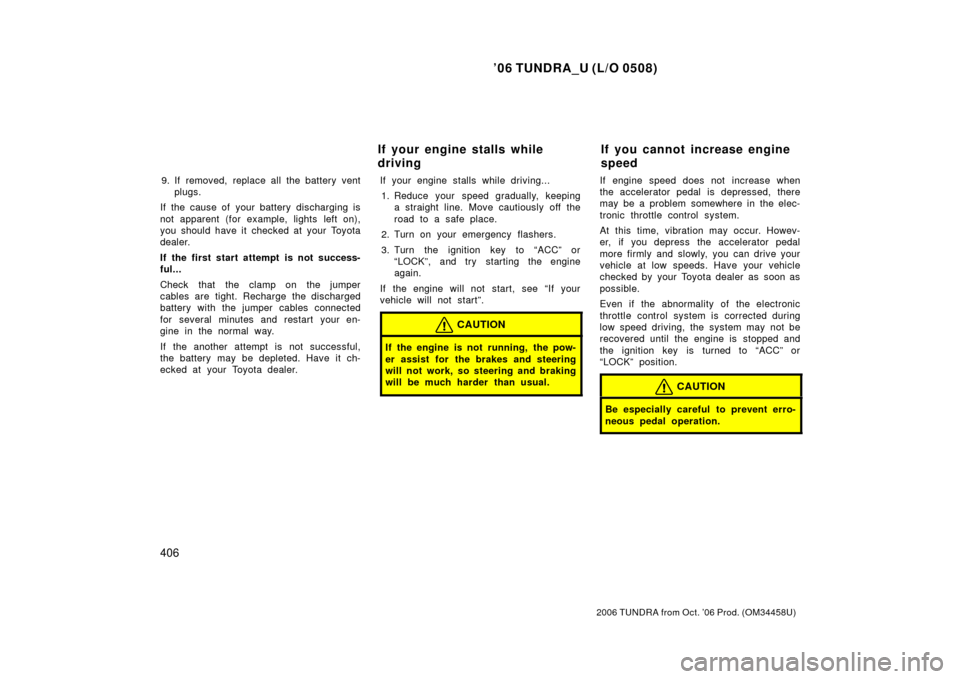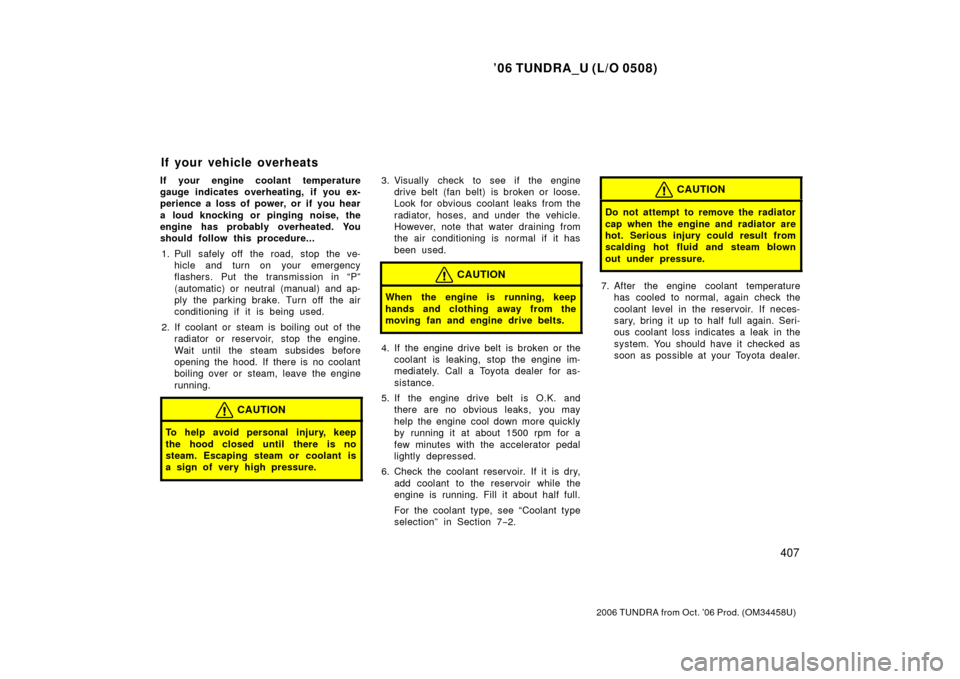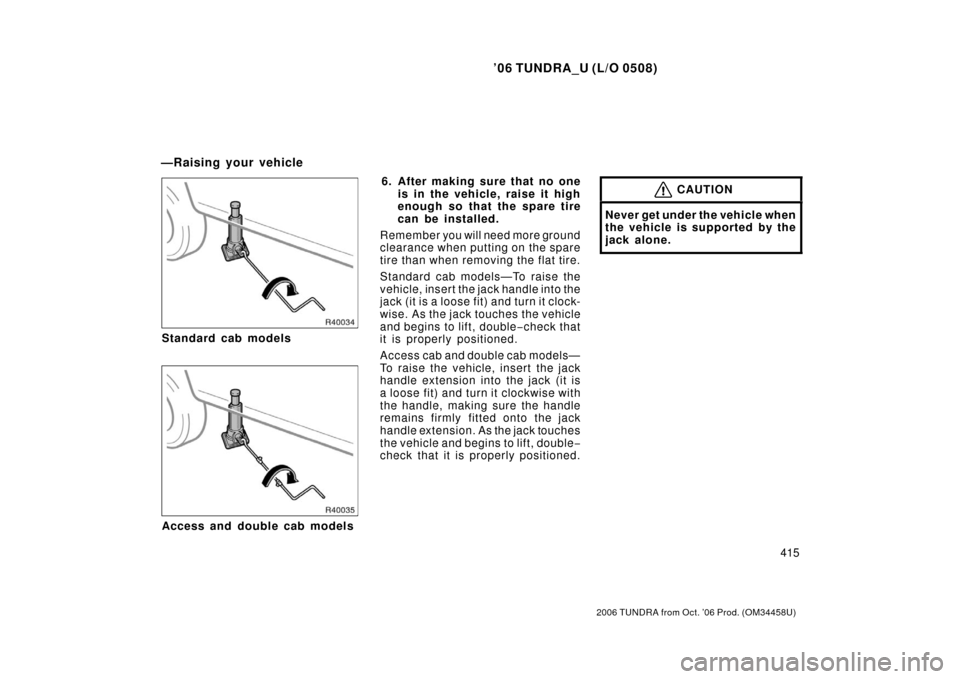Page 413 of 527

’06 TUNDRA_U (L/O 0508)
401
2006 TUNDRA from Oct. ’06 Prod. (OM 34458U)
IN CASE OF AN EMERGENCY
In case of an emergency
If your vehicle will not start 402
. . . . . . . . . . . . . . . . . . . . . . . . . . . . . . . . . . .
If your engine stalls while driving 406
. . . . . . . . . . . . . . . . . . . . . . . . . . . . .
If you cannot increase engine speed 406
. . . . . . . . . . . . . . . . . . . . . . . . . .
If your vehicle overheats 407
. . . . . . . . . . . . . . . . . . . . . . . . . . . . . . . . . . . . \
If you have a flat tire 408
. . . . . . . . . . . . . . . . . . . . . . . . . . . . . . . . . . . . \
. . . . .
If your vehicle becomes stuck 420
. . . . . . . . . . . . . . . . . . . . . . . . . . . . . . . .
If your vehicle needs to be towed 420
. . . . . . . . . . . . . . . . . . . . . . . . . . . . .
If you lose your keys 426
. . . . . . . . . . . . . . . . . . . . . . . . . . . . . . . . . . . . \
. . . .
If you lose your wireless remote control transmitter 426
. . . . . . . . . . . . .
SECTION 4
Page 418 of 527

’06 TUNDRA_U (L/O 0508)
406
2006 TUNDRA from Oct. ’06 Prod. (OM 34458U)
9. If removed, replace all the battery vent
plugs.
If the cause of your battery discharging is
not apparent (for example, lights left on),
you should have it checked at your Toyota
dealer.
If the first start attempt is not success-
ful...
Check that the clamp on the jumper
cables are tight. Recharge the discharged
battery with the jumper cables connected
for several minutes and restart your en-
gine in the normal way.
If the another attempt is not successful,
the battery may be depleted. Have it ch-
ecked at your Toyota dealer. If your engine stalls while driving...
1. Reduce your speed gradually, keeping a straight line. Move cautiously off the
road to a safe place.
2. Turn on your emergency flashers.
3. Turn the ignition key to “ACC” or “LOCK”, and try starting the engine
again.
If the engine will not start, see “If your
vehicle will not start”.
CAUTION
If the engine is not running, the pow-
er assist for the brakes and steering
will not work, so steering and braking
will be much harder than usual.
If engine speed does not increase when
the accelerator pedal is depressed, there
may be a problem somewhere in the elec-
tronic throttle control system.
At this time, vibration may occur. Howev-
er, if you depress the accelerator pedal
more firmly and slowly, you can drive your
vehicle at low speeds. Have your vehicle
checked by your Toyota dealer as soon as
possible.
Even if the abnormality of the electronic
throttle control system is corrected during
low speed driving, the system may not be
recovered until the engine is stopped and
the ignition key is turned to “ACC” or
“LOCK” position.
CAUTION
Be especially careful to prevent erro-
neous pedal operation.
If your engine stalls while
driving If you cannot incr
ease engine
speed
Page 419 of 527

’06 TUNDRA_U (L/O 0508)
407
2006 TUNDRA from Oct. ’06 Prod. (OM 34458U)
If your engine coolant temperature
gauge indicates overheating, if you ex-
perience a loss of power, or if you hear
a loud knocking or pinging noise, the
engine has probably overheated. You
should follow this procedure...
1. Pull safely off the road, stop the ve- hicle and turn on your emergency
flashers. Put the transmission in “P”
(automatic) or neutral (manual) and ap-
ply the parking brake. Turn off the air
conditioning if it is being used.
2. If coolant or steam is boiling out of the radiator or reservoir, stop the engine.
Wait until the steam subsides before
opening the hood. If there is no coolant
boiling over or steam, leave the engine
running.
CAUTION
To help avoid personal injury, keep
the hood closed until there is no
steam. Escaping steam or coolant is
a sign of very high pressure.
3. Visually check to see if the enginedrive belt (fan belt) is broken or loose.
Look for obvious coolant leaks from the
radiator, hoses, and under the vehicle.
However, note that water draining from
the air conditioning is normal if it has
been used.
CAUTION
When the engine is running, keep
hands and clothing away from the
moving fan and engine drive belts.
4. If the engine drive belt is broken or thecoolant is leaking, stop the engine im-
mediately. Call a Toyota dealer for as-
sistance.
5. If the engine drive belt is O.K. and there are no obvious leaks, you may
help the engine cool down more quickly
by running it at about 1500 rpm for a
few minutes with the accelerator pedal
lightly depressed.
6. Check the coolant reservoir. If it is dry, add coolant to the reservoir while the
engine is running. Fill it about half full.
For the coolant type, see “Coolant type
selection” in Section 7 −2.
CAUTION
Do not attempt to remove the radiator
cap when the engine and radiator are
hot. Serious injury could result from
scalding hot fluid and steam blown
out under pressure.
7. After the engine coolant temperature
has cooled to normal, again check the
coolant level in the reservoir. If neces-
sary, bring it up to half full again. Seri-
ous coolant loss indicates a leak in the
system. You s hould have it checked as
soon as possible at your Toyota dealer.
If your vehicle overheats
Page 421 of 527
’06 TUNDRA_U (L/O 0508)
409
2006 TUNDRA from Oct. ’06 Prod. (OM 34458U)
NOTICE
Do not continue driving with a
deflated tire. Driving even a
short distance can damage a
tire and wheel beyond repair.
1. Get the required tools and
spare tire.
1 Jack handle
2 Wheel nut wrench
3Jack
To prepare yourself for an emergency,
you should familiarize yourself with
the use of the jack, each of the tools
and their storage locations.Turn the jack joint by hand.
To rem ov e: Tur n the joint in direction
1 until the jack is free.
To store: Turn the joint in direction 2
until the jack is fi rmly secured to pre-
vent it flying forward during a collision
or sudden braking.
—Required tools and spare tire
(standard cab models)
Page 424 of 527
’06 TUNDRA_U (L/O 0508)
412
2006 TUNDRA from Oct. ’06 Prod. (OM 34458U)
2. Block the wheel diagonally op-
posite the flat tire to keep the
vehicle from rolling when it is
jacked up.
When blocking the wheel, place a
wheel block in front of one of the front
wheels or behind one of the rear
wheels.Ty p e A
Ty p e B
Ty p e C
Ty p e D
—Blocking the wheel —Removing wheel ornament
Page 427 of 527

’06 TUNDRA_U (L/O 0508)
415
2006 TUNDRA from Oct. ’06 Prod. (OM 34458U)
Standard cab models
Access and double cab models 6. After making sure that no one
is in the vehicle, raise it high
enough so that the spare tire
can be installed.
Remember you will need more ground
clearance when putting on the spare
tire than when removing the flat tire.
Standard cab models—To raise the
vehicle, insert the jack handle into the
jack (it is a loose fit) and turn it clock-
wise. As the jack touches the vehicle
and begins to lift, double− check that
it is properly positioned.
Access cab and double cab models—
To raise the vehicl e, insert the jack
handle extension into the jack (it is
a loose fit) and turn it clockwise with
the handle, making sure the handle
remains firmly fitted onto the jack
handle extension. As the jack touches
the vehicle and begins to lift, double −
check that it is properly positioned.
CAUTION
Never get under the vehicle when
the vehicle is supported by the
jack alone.
—Raising your vehicle
Page 428 of 527
’06 TUNDRA_U (L/O 0508)
416
2006 TUNDRA from Oct. ’06 Prod. (OM 34458U)
7. Remove the wheel nuts and
change tires.
Lift the flat tire straight off and put it
aside.
Roll the spare wheel into position and
align the holes in the wheel with the
bolts. Then lift up the wheel and get
at least the top bolt started through
its hole. Wiggle the tire and press it
back over the other bolts.Before putting on wheels, remove any
corrosion on the mounting surfaces
with a wire brush or such. Installation
of wheels without good metal− to−met-
al contact at the mounting surface can
cause wheel nuts to loosen and
eventually cause a wheel to come off
while driving.8. Reinstall all the wheel nuts fin- ger tight.
Reinstall the wheel nuts (tapered end
inward) and tighten them as much as
you can by hand. Press back on the
tire back and see if you can tighten
them more.
—Changing wheels —Reinstalling wheel nuts
Page 431 of 527

’06 TUNDRA_U (L/O 0508)
419
2006 TUNDRA from Oct. ’06 Prod. (OM 34458U)
CAUTION
�Take due care in handling the
ornament to avoid unexpected
personal injury.
� Do not attach a heavily dam-
aged plastic wheel ornament.
It may fly off the wheel and
cause accidents while the ve-
hicle is moving.
11. Check the air pressure of the re-
placed tire.
Adjust the air pressu re to the specifi-
cation designated in Section 8. If the
pressure is lower, drive slowly to the
nearest service station and fill to the
correct pressure.
Do not forget to reinstall the tire infla-
tion valve cap as dirt and moisture
could get into th e valve core and
possibly cause air leakage. If the cap
is missing, have a new one put on as
soon as possible.
12.Restow all the tools, jack and flat tire securely.
With a spare tire of the same wheel
type as the installed tires—
As soon after changing wheels as
possible, tighten the wheel nuts to the
torque specified in Section 8 with a
torque wrench. Have a technician re-
pair the flat tire.
With a spare tire of different wheel
type from the installed tires— As soon after changing wheels as
possible, tighten the wheel nuts to the
torque specified in Section 8 with a
torque wrench. Have a technician re-
pair the flat tire and replace the spare
tire with it.
CAUTION
Before driving, make sure all the
tools, jack and flat tire are se-
curely in place in their storage
location to reduce the possibility
of personal injury during a colli-
sion or sudden braking.
Initial adjustment of the tire pres-
sure warning system is necessary
after you have rotated your tires.
See “Tire pressure warning sys-
tem” in Section 1�7.
—After changing wheels